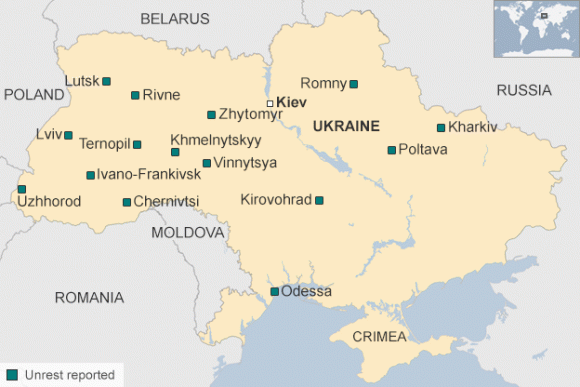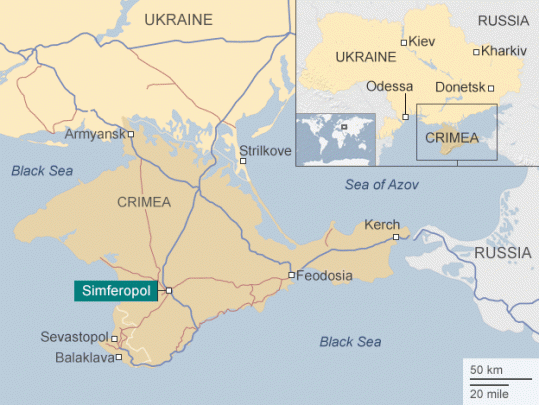

Ukraine, asymmetric or dissymmetric war?

(Fonte: BBC)
Guerra in Ucraina…asimmetrie e convenzionalità in una guerra attuale: quel che c’è di possibile…
Il Direttore scientifico: Maria Gabriella Pasqualini
The military operations of the “green men” and separatists in Ukraine could be described as hybrid warfare according to a series of criteria: use of regular and irregular forces, strong links with criminal groups, unclear distinction between civilians and soldiers and military activities in situations in which war is actually not declared. Such a strategy could be considered as a kind of asymmetric warfare.
Asymmetric warfare consists of two sides in a conflict which have totally different strategies, strengths and weaknesses. Both resort to different types of asymmetric tactics to achieve more advantages on the other one. The weakest force such as the local pro-Russian separatists in eastern Ukraine will try to inflict the highest economic and human costs on its more powerful adversary to turn the conflict into a war of attrition while the strongest force (Ukraine) will limit operations because it is unable to support the increasily growing economic and human costs of the conflict.
Furthermore, one main aim of asymmetric warfare is to make any countermove of the stronger force, such as the current deployment of Russian “peacekeepers” on the Ukrainian soil, like a considerable and unwarranted escalation.
Asymmetrical actions include informational ones as well. Therefore the employment of media and propaganda is extremely helpful to reduce the enemy’s fighting potential, because all countries involved in wars of this type want to support and justify their operations by denying any violation of international law. It is primarily a figurative war of narratives in which favorable ones are reinforced and multiplied while “foreign” interpretations are neutralized and pushed to the margins where they pose no threat.
Therefore defensive tactics would lead to defeat in this kind of war. Russia has accordingly revised its approach defining the threat in eastern Ukraine as an offensive war, therefore Russian dezinformatsia is increasing a purported anarchy in eastern Ukraine and the right of separatists to self-determination.
The opposite of asymmetric warfare is dissymmetric warfare involving massive force against a weaker opponent in a military conflict. Ukraine has both asymmetric and dissymmetric dimensions in the war in eastern Ukraine. Pro-Russian separatists promote an asymmetric warfare against the Ukrainian government while Russia prosecutes a parallel dissymmetric one. The Ukrainian government has been unable to change the asymmetric war against pro-Russian separatists into a dissymmetric one in which the Ukraine could exploit its advantages. This reflects several factors. The separatist forces have convincingly demonstrated a higher ‘esprit de corps’ than the Ukrainian separatist forces whose regular army units are increasingly dependent upon conscripts (Ukraine’s risky gambit to limit army units by deploying ultra-nationalist paramilitary units to front line positions). Separatist forces have also limited their actions to waging a classic asymmetric conflict that makes an optimal use of terrain and guerrilla warfare tactics.
Moreover, the dissymmetric war in eastern Ukraine is mostly a cybered conflict. Ukraine faces a determined and capable adversary, the Russian government, highly skilled in using dezinformatsia to currently impose virtual costs and virtual collateral damages on Ukraine. The large hostile use of information and communication technologies is mainly used by the Russian government to influence adversary-state’s information resources and cause damage to telecommunication systems.
This includes promoting disinformation and virtual depictions in cyberspace misrepresenting reality with the aim of disorienting, destabilizing and demoralizing a civilian population. Disinformation, rightly used, can significantly and considerably develop a “shock and awe” effect that saps an adversary’s willingness to fight distorting how civilians perceive and understand the conflict.
The Russian cyber-supremacy has currently become the Ukraine’s second ungovernable front in which it is fighting an unconventional cybered war alongside the conventional one on the soil of eastern Ukraine.
©www.osservatorioanalitico.com – Riproduzione riservata

(Fonte: BBC)

Commenti recenti